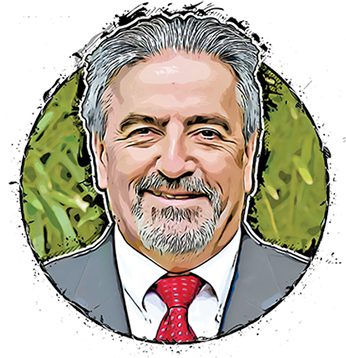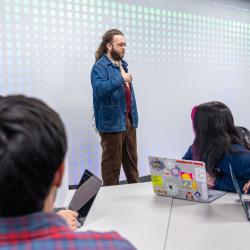Alumni Climate Crusaders
Confronting Climate Change
We see the signs everywhere—our planet’s future is in jeopardy. As global temperatures rise, greenhouse gases reach record levels and extreme weather events strike more frequently, we must ask the question: What will it take to solve the grand challenge of climate change?
Researchers in the University of Maryland’s College of Computer, Mathematical, and Natural Sciences (CMNS) are fiercely committed to the fight against global warming. These scientists are tapping into satellite data to predict crop-killing droughts before they happen, identifying trees that adapt to climate change instead of worsening it, and unraveling the complex relationship between airborne pollutants and weather conditions. Grand challenges demand bold ideas and real-world solutions. In CMNS, we lead Fearlessly Forward.
Fighting Against Climate Change and For Social Justice

For Crystal Upperman (Ph.D. ’16, marine estuarine environmental sciences), climate change is a fight for people of color and for social justice.
“The same emissions that are changing our climate are the ones that are changing us and impacting the health of children,” Upperman explained. “Black people, Hispanics and Asians have higher exposure to air pollution than whites.”
She’s committed to changing that.
“I’ve lived in frontline communities all my life,” Upperman said. “This mission is essential to me as a person.”
As a senior scientist at Aclima, Upperman used the company’s next-generation platform to measure air pollution and its impact block by block, advocating for solutions that protect public health and advance environmental justice. She later led a push for climate-friendly and socially responsible strategies as vice president of climate resilience and social performance for AECOM.
Now, as a senior manager at Deloitte, Upperman helps clients develop and implement more climate-friendly policies, particularly in communities highly burdened by pollution.
“We’ve seen the fallout that results from not being responsive to social justice concerns and climate concerns,” Upperman explained. “It’s great to be able to show that there are values that are supportive of social justice and also supportive of protection of the environment.”
Why Phytoplankton Could Be a Game-Changer for the Environment

Phytoplankton—microscopic algae in water—absorb carbon and emit oxygen like land plants and may be key players in our search for understanding climate change, according to Beth Weinstein (B.S. ’01, computer science).
While at UMD, Weinstein met with recruiters from NASA’s Goddard Space Flight Center at a campus networking event and was interviewed on the spot. She graduated with a job working on NASA’s Earth Science Data Systems program, which makes NASA’s satellite data free to the public.
After working with Earth Science Data Systems for seven years, Weinstein transitioned to building satellites herself. She now works on the Plankton, Aerosol, Cloud, ocean Ecosystem (PACE) satellite mission, which expanded her perspective on climate change solutions.
“Before PACE, I had no idea how much phytoplankton could affect carbon levels in the atmosphere,” Weinstein said. “Learning about how our ocean-atmosphere system works and how our aerosol-cloud system works, we can be more creative about how to combat climate change.”
Launching in January 2024, the PACE satellite will scan the globe every two days for oceanic and atmospheric changes. It will give scientists in-depth knowledge of how phytoplankton respond to Earth’s changing climate and could potentially be used to reduce carbon levels and address climate change.
Tackling Climate Change for Federal Clients

Steve Ambrose’s (B.S. ’76, physical sciences) interest in the environment was ignited in the 1960s by musicians like John Denver and Jethro Tull, who sang about taking care of our planet, as well as a visit to the World’s Fair in New York in 1964. That interest solidified in 1972 after he saw the devastating impact of Hurricane Agnes on much of the East Coast.
At UMD, Ambrose majored in physical sciences to explore his passions in meteorology, geology and astronomy. As chief climate scientist at Science Applications International Corp. (SAIC) and head of the SAIC Climate Enterprise, Ambrose calls his role a “once-in-a-lifetime opportunity to make a difference.”
“It gives me the chance to lead SAIC in advancing solutions for climate change, and I’m really committed to establishing SAIC as a leader in climate science,” Ambrose said.
After Ambrose graduated, he worked at the National Oceanic and Atmospheric Administration’s (NOAA) National Ocean Service analyzing tide data, continuing at NOAA’s National Weather Service and the National Environmental Satellite, Data, and Information Service. Across his career, Ambrose has worked to protect the environment and provide knowledge and understanding of weather and climate observations, data and models for more than 40 years.
“The data is clear: Climate change is an increasing threat to society,” Ambrose said. “Technology and innovation will help us collect data to understand these changes; analyzing that data will help us understand how we can best be resilient and adapt to climate change.”
Combating Environmental Inequality Worldwide

Born in Bosnia and Herzegovina, Saliha Dobardzic (M.S. ’00, sustainable development and conservation biology) spent her formative years living in different countries with her family. She learned early on that a healthy environment can be a form of wealth—and that an unhealthy environment can take a disproportionate toll on the most vulnerable.
“Children, the elderly, the disabled and generally discriminated-against groups tend to disproportionately suffer the effects of environmental degradation, such as pollution and loss of nature’s services,” Dobardzic said.
Dobardzic is working to change that as senior climate change specialist for the Adaptation Fund. The organization finances programs that help vulnerable communities in developing countries adapt to climate change. Since 2010, the Adaptation Fund committed $924 million to over 130 projects spanning more than 100 countries and benefiting over 30 million people.
Projects range from establishing water infrastructure in Djibouti to improving agricultural productivity in Tanzania to supporting innovation in water services in peri-urban areas of Chile. Dobardzic’s graduate studies in conservation at UMD, as well as subsequent studies in geography, provided a strong foundation for her work.
“Studying in pioneering, interdisciplinary graduate programs at Maryland made me aware of different ways to view problems and, likewise, ways of tackling them,” Dobardzic said. “Integrating perspectives from different disciplines is essential when dealing with a complex, multifaceted problem like climate change.”
Written by Katie Bemb and Leslie Miller
This article was published in the Summer 2022 issue of Odyssey magazine. To read other stories from that issue, please visit go.umd.edu/odyssey.
Also from this issue:







